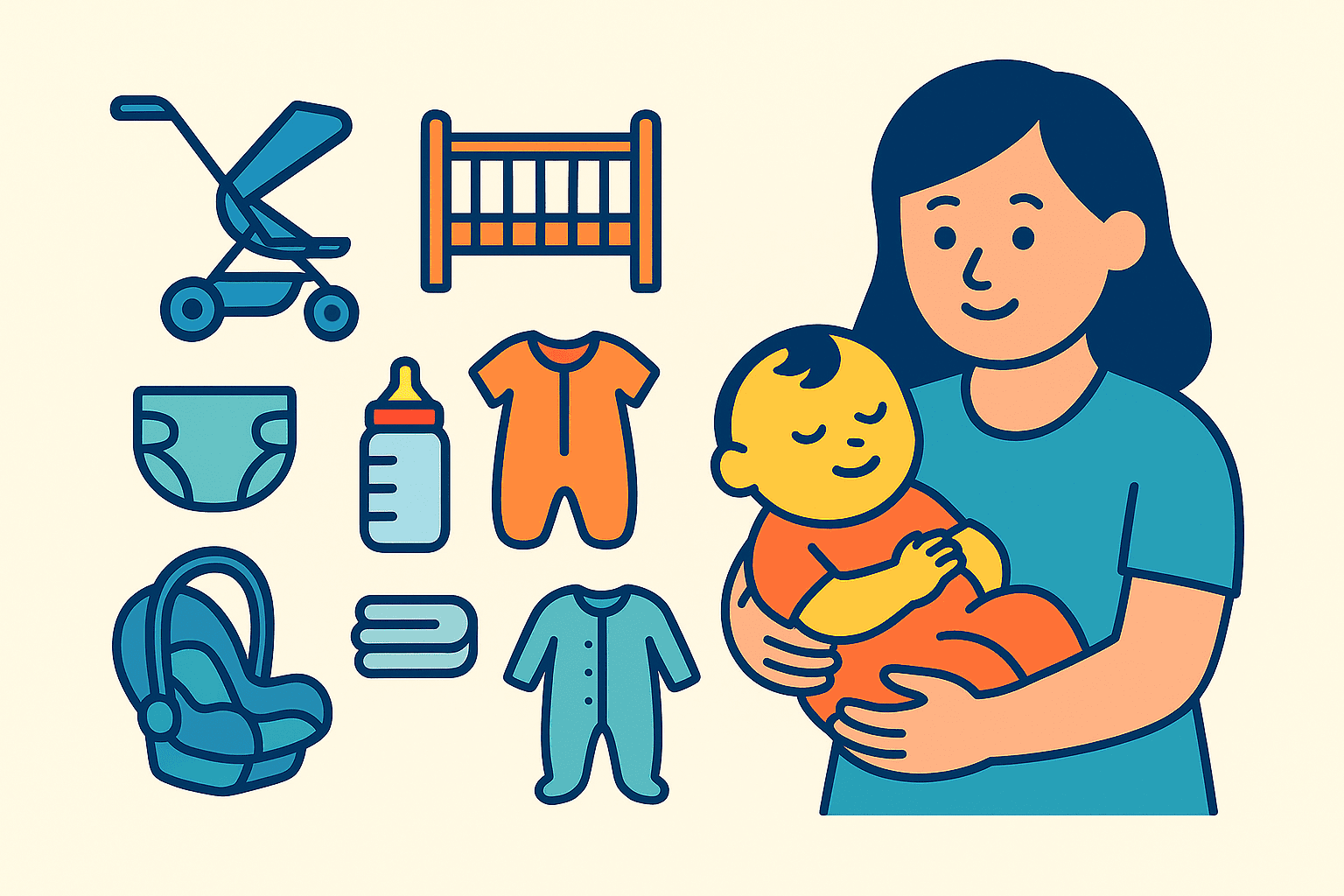*We're parents too. By buying products via our affiliate links we may earn a commission to support our growing family at no cost to you!
Baby Registry Checklist 2025: Complete Guide for New Parents
Quick Answer
A complete baby registry checklist includes essentials in these categories: safe sleep (crib, mattress, bassinet), transportation (car seat, stroller), feeding (bottles, breast pump, high chair), diapering (diaper bag, changing supplies), monitoring (baby monitor), and safety items. Focus on essentials first and add convenience items based on your lifestyle.
In This Guide
- Complete checklist organized by category
- Essential items for each category
- Product recommendations from expert reviews
- Tips for prioritizing registry items
- Printable checklist reference
- Budget-friendly alternatives
Creating your baby registry checklist feels overwhelming. You need many items organized across categories. This guide breaks down everything into manageable sections so you build a complete registry without missing essentials.
Focus on essentials first. Add convenience items later based on your lifestyle and space. Many items you need before baby arrives. Others can wait until you discover what works for your family.
Create Your Registry Today
Amazon Baby Registry
*Subject to availability and Retailer's terms.
We earn commissions from these links.
All Products in This Guide
Essential products organized by category for your complete baby registry
Our Registry Recommendations
(7 products)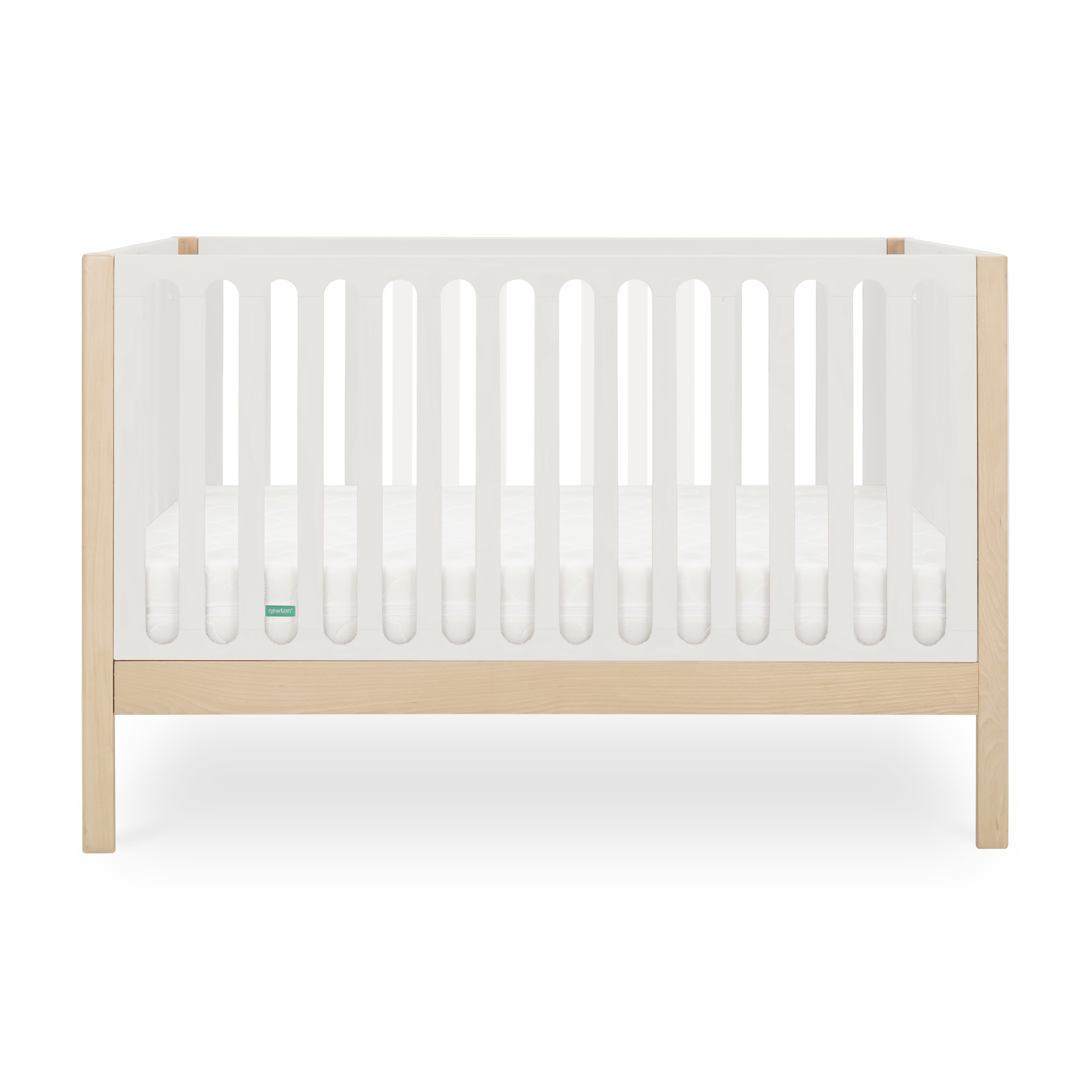





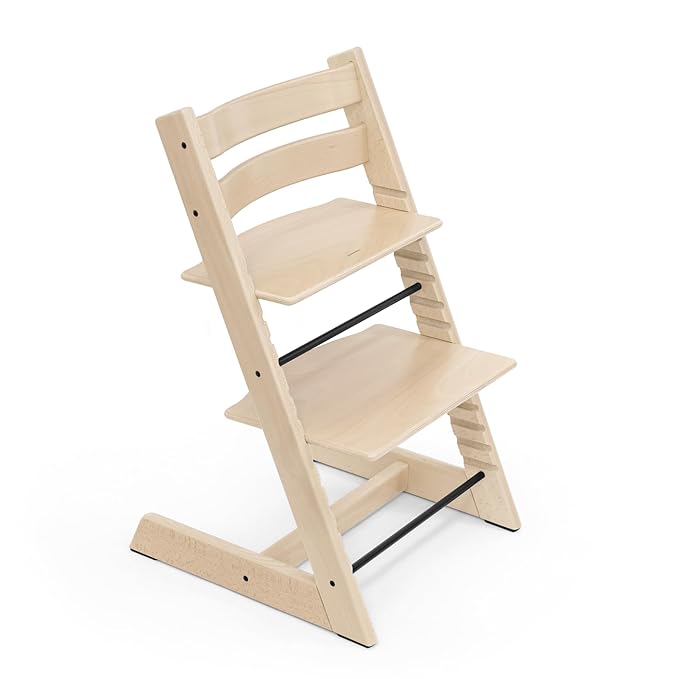
Complete Baby Registry Checklist by Category
Organize your registry by category to avoid missing items. Start with safety essentials. Add convenience items based on your lifestyle and space.
Safe Sleep Essentials
Every baby needs a safe sleep space. Plan for newborn and longer-term sleeping options.
Bassinet (Newborn to 4-6 months):
- Bassinet with firm, flat surface
- Breathable sleep sack or swaddle
- Fitted sheets for bassinet mattress
- White noise machine (optional)
Crib Setup (4-6 months and beyond):
- Convertible crib (grows to toddler bed)
- Firm crib mattress (meets safety standards)
- Fitted crib sheets (2-3 sets)
- Sleep sack or wearable blanket
- Crib mattress protector
Monitor and Safety:
- Baby monitor with video and audio
- Carbon monoxide detector
- Smoke detector in nursery
- Room temperature monitor
Sleep Safety Tip
Babies should sleep alone on their back on a firm, flat surface. Avoid soft bedding, blankets, pillows, or bumpers in the sleep area. Use a sleep sack instead of loose blankets.
Transportation Essentials
You cannot leave the hospital without a car seat. Plan your transportation setup before baby arrives.
Car Seat (Required for hospital discharge):
- Infant car seat or convertible car seat
- Car seat base (if using infant seat)
- Car seat installation check
Stroller:
- Full-size stroller or travel stroller
- Stroller compatible with your car seat
- Stroller accessories (cup holder, organizer)
Additional Transportation:
- Baby carrier or wrap (for hands-free carrying)
- Diaper bag or backpack
- Stroller accessories (weather cover, footmuff)
Car Seat Safety
Infant car seats install rear-facing and typically fit babies up to 30-35 pounds. Convertible car seats work rear-facing and forward-facing and last longer. Both need proper installation for safety.
Feeding Essentials
Feeding setups vary by feeding method. Prepare for both breastfeeding and formula feeding.
Breastfeeding Supplies:
- Breast pump (electric or manual)
- Nursing bras (2-3)
- Nursing pillow
- Nipple cream or balm
- Breast milk storage bags or containers
- Nursing cover (optional)
Bottle Feeding Supplies:
- Baby bottles (4-6 newborn size)
- Bottle nipples (various flow rates)
- Bottle warmer
- Bottle brush and cleaning supplies
- Formula dispenser (if using formula)
Feeding Gear (6+ months):
- High chair
- Baby spoons and bowls
- Sippy cups
- Bibs (multiple)
- Placemat or splash mat
Solid Food Prep (6+ months):
- Food processor or blender
- Ice cube trays for purees
- Freezer storage containers
- Mesh feeders (for safe finger foods)
Feeding Preparation
Prepare for both feeding methods even if you plan to breastfeed exclusively. Many parents use bottles occasionally. Having supplies ready prevents last-minute purchases.
Diapering Essentials
Diapering needs are consistent across all babies. Stock up on basics and keep supplies organized.
Diapers and Wipes:
- Newborn diapers (1-2 boxes)
- Size 1 diapers (2-3 boxes)
- Baby wipes (multiple packages)
- Diaper rash cream
- Changing pad liners
Changing Station:
- Changing pad
- Changing table or dresser top pad
- Diaper pail or trash can
- Diaper organizer or caddy
Diaper Bag Supplies:
- Diaper bag or backpack
- Portable changing pad
- Travel-size wipes container
- Extra diapers
- Spare change of clothes
Bathing and Grooming
Bathing routines start early. Gather supplies for safe, comfortable bath times.
Bath Essentials:
- Baby bathtub or bath seat
- Soft washcloths (4-6)
- Hooded towels (2-3)
- Baby-safe soap and shampoo
- Bath thermometer
- Bath toys (for older babies)
Grooming Supplies:
- Nail clippers or file
- Soft-bristle hairbrush
- Baby lotion
- Nasal aspirator
- Thermometer
- Medicine dispenser
Clothing Essentials
Babies grow quickly. Stock up on basics in multiple sizes. Focus on comfort and ease of dressing.
Newborn Clothing (0-3 months):
- Onesies (6-8)
- Sleepers or pajamas (4-6)
- Socks (6-8 pairs)
- Hats (2-3)
- Mittens (2 pairs)
3-6 Month Clothing:
- Onesies (4-6)
- Sleepers (4-6)
- Pants or leggings (4-6)
- Socks (6-8 pairs)
Layering and Outerwear:
- Swaddle blankets (4-6)
- Receiving blankets (6-8)
- Sleep sack (1-2, various TOG ratings)
- Outerwear (seasonal)
Clothing Sizing
Babies grow quickly in the first year. You might not need many newborn sizes. Size 0-3 months and 3-6 months get more use. Include some 6-9 month sizes for growth.
Nursery and Organization
Organize your nursery for efficiency and comfort. Plan storage and organization systems early.
Nursery Furniture:
- Crib or bassinet
- Dresser or changing table
- Rocking chair or glider
- Storage solutions (bins, baskets)
- Bookshelf or toy storage
Organization:
- Drawer organizers
- Hanging closet organizers
- Storage bins with labels
- Laundry hamper
- Wall hooks for bags
Nursery Decor (Optional):
- Blackout curtains or blinds
- Night light
- Mobile for crib
- Wall art or decals
- Area rug
Safety and Babyproofing
Safety starts from day one. Some items you need early. Others can wait until baby becomes mobile.
Early Safety Items:
- Baby monitor
- Outlet covers
- Corner guards
- Cabinet locks
- Door knob covers
Babyproofing (When Baby Becomes Mobile):
- Safety gates
- Furniture anchors
- Appliance locks
- Toilet locks
- Stair gates
Health and Medical Supplies
Keep medical supplies on hand for common infant needs. Consult your pediatrician for recommendations.
Medical Essentials:
- Digital thermometer
- Nasal aspirator
- Medicine dispenser
- Infant pain reliever (pediatrician-approved)
- First aid kit
- Humidifier (for cold/flu season)
Healthcare Basics:
- Baby-safe sunscreen (6+ months)
- Diaper rash ointment
- Gas drops (pediatrician-approved)
- Teething relief (when needed)
Prioritizing Your Registry Items
Not all items have equal priority. Organize your registry by urgency and importance.
Priority 1: Before Baby Arrives (Must-Haves):
- Car seat (hospital requirement)
- Safe sleep space (bassinet or crib)
- Basic clothing (newborn and 0-3 months)
- Diapers and wipes
- Feeding supplies (based on your plan)
- Basic hygiene items
Priority 2: First Month (High Priority):
- Baby monitor
- Diaper bag
- Additional clothing in next sizes
- Swaddles or sleep sacks
- Bottle feeding supplies (if using)
- Breastfeeding supplies (if breastfeeding)
Priority 3: First 3-6 Months (Important):
- Crib setup (if using bassinet first)
- High chair (around 6 months)
- Baby carrier
- Additional feeding supplies
- Toys and stimulation items
Priority 4: Later Additions (Nice-to-Haves):
- Babyproofing items (when baby becomes mobile)
- Activity center or jumper
- Additional stroller accessories
- Nursery decor items
- Specialty items based on lifestyle
Registry Strategy
Start with absolute essentials you need before baby arrives. Add items for the first month next. Include later-stage items on your registry so you can use completion discounts when you need them.
Registry Tips by Lifestyle
Your lifestyle determines which items you need most. Adjust your checklist based on your situation.
For Small Spaces:
- Mini crib or portable crib
- Foldable high chair
- Compact stroller
- Multi-use furniture
- Vertical storage solutions
For detailed small space registry tips, see our registry checklist for small spaces guide.
For Working Parents:
- Hands-free breast pump
- Baby monitor with app access
- Convenient diaper bag
- Time-saving feeding supplies
- Efficient organization systems
For working parent specific recommendations, see our best baby products for working parents guide.
For Frequent Travelers:
- Lightweight travel stroller
- Portable crib or travel bed
- Compact baby carrier
- Travel-friendly diaper bag
- Packable high chair
For Budget-Conscious Families:
- Convertible items (grow with baby)
- Multi-use products
- Store brand basics
- Secondhand furniture (safety-checked)
- Registry completion discounts
Printable Checklist Reference
Use this checklist to track items as you add them to your registry.
Safe Sleep
Transportation
Feeding
Diapering
Clothing
Bathing and Grooming
Nursery
Safety
Health
Expert Product Recommendations
We researched and tested products across categories. These recommendations balance quality, safety, and value.
Best Crib: Newton Galileo 3-in-1 Convertible Crib
Convertible cribs grow with your baby. This crib converts from infant crib to toddler bed. Solid construction meets safety standards. GREENGUARD Gold certification ensures low emissions.
Newton Galileo 3-in-1 Convertible Crib
Premium convertible crib with solid beech wood construction and GREENGUARD Gold certification
Product Specifications
Why We Recommend It
Premium convertible crib with solid beech wood construction and GREENGUARD Gold certification
Pros
- • Solid beech wood construction
- • GREENGUARD Gold certified for low emissions
- • 3-in-1 convertible design
- • Easy assembly with clear instructions
- • Modern aesthetic with clean lines
Cons
- • High price point
- • Toddler conversion kit sold separately
- • Limited color options
- • Heavy weight (60 lbs)
- • New product with limited reviews
Safety & Testing
GREENGUARD Gold, JPMA, ASTM F1169, CPSC
Best Mattress: Newton Original Crib Mattress
Breathable, washable mattress supports safe sleep. The Wovenaire core allows airflow while providing support. Completely washable design simplifies cleaning. Dual firmness works for infants and toddlers.
Newton Original Crib Mattress
Ultra-breathable & washable crib mattress with 5.5 inches thick and features a soft, quilted removable cover
Product Specifications
Why We Recommend It
Ultra-breathable & washable crib mattress with 5.5 inches thick and features a soft, quilted removable cover
Pros
- • 100% breathable - baby can breathe through it
- • Completely washable (core and cover)
- • Dual firmness for infant and toddler stages
- • No chemical smell or off-gassing
- • Lightweight and easy to handle
Cons
- • High price point
- • Firm infant side (by design for safety)
- • Heavy when wet after washing
- • Requires separate waterproof cover if desired
- • Limited color options
Safety & Testing
GREENGUARD Gold, CertiPUR-US, OEKO-TEX Standard 100
Best Bassinet: HALO BassiNest Swivel Sleeper 3.0
Swivel bassinet provides safe sleep for newborns. The swivel design allows easy access from your bed. Breathable mesh sides promote airflow. Lowering side panel helps with nighttime access.
HALO BassiNest Swivel Sleeper 3.0
Over-bed baby bassinet with 360 rotation, adjustable height, breathable mesh
Product Specifications
Why We Recommend It
Over-bed baby bassinet with 360 rotation, adjustable height, breathable mesh
Pros
- • 360-degree swivel movement
- • Lowering wall for easy access
- • Breathable mesh walls
- • Height adjustable up to 30"
- • Portable design with detachable nest
Cons
- • High price point
- • Large base footprint
- • May be flimsy for some users
- • Limited use period (newborn only)
- • Assembly required
Safety & Testing
JPMA certified, ASTM F2194
Best Baby Monitor: Infant Optics DXR-8 PRO Video Baby Monitor
Non-WiFi monitor provides reliable video and audio monitoring. No internet required means better privacy and security. Clear night vision and two-way audio keep you connected.
Infant Optics DXR-8 PRO Standalone Monitor
Standalone monitor unit for DXR-8 PRO system (battery and camera sold separately)
Product Specifications
Why We Recommend It
Standalone monitor unit for DXR-8 PRO system (battery and camera sold separately)
Pros
- • Standalone monitor unit for DXR-8 PRO system
- • 5" HD display screen
- • 2-way audio communication
- • Compatible with existing DXR-8 PRO cameras
- • Replacement component for existing owners
- • Crystal-clear 5" HD display
- • Expandable system
- • Good battery life
- • Reliable connection
Cons
- • Battery NOT included (sold separately)
- • Camera unit NOT included (sold separately)
- • Does not work by itself
- • Requires existing DXR-8 PRO full kit
- • Replacement component only
- • Higher cost for complete system
- • Limited to DXR-8 compatibility
- • No WiFi features
- • Basic functionality
Safety & Testing
FCC certified, ASTM standards
For complete monitoring coverage, use the Infant Optics DXR-8 PRO Add-on Camera for multi-room monitoring.
Infant Optics DXR-8 PRO Add-on Camera
Additional camera unit for Infant Optics DXR-8 PRO system
Product Specifications
Why We Recommend It
Additional camera unit for Infant Optics DXR-8 PRO system
Pros
- • Additional camera for DXR-8 PRO system
- • Remote pan/tilt/zoom functionality
- • Night vision capability
- • Remote thermometer included
- • Interchangeable lens system
Cons
- • Not compatible with DXR-8 (3.5" model)
- • Zoom lens sold separately
- • Wide angle lens sold separately
- • Requires existing DXR-8 PRO system
- • Additional cost for complete setup
Safety & Testing
FCC certified, ASTM standards
Best Diaper Bag: Skip Hop Forma Backpack
Organized backpack design keeps essentials accessible. Multiple pockets organize diapers, bottles, and personal items. Laptop compartment works for working parents. Comfortable straps distribute weight evenly.
Skip Hop Forma Backpack
Skip Hop Diaper Bag Backpack: Forma, Multi-Function Baby Travel Bag with Changing Pad & Stroller Attachment, Jet Black
Product Specifications
Why We Recommend It
Skip Hop Diaper Bag Backpack: Forma, Multi-Function Baby Travel Bag with Changing Pad & Stroller Attachment, Jet Black
Pros
- • Lightweight quilted backpack design
- • Extra-wide opening with two-way zip closure
- • Two insulated side bottle pockets
- • Elasticized interior pockets and cell phone pocket
- • Changing pad pocket holds tablets and laptops up to 15"
- • Padded backpack straps (adjustable 13" to 28")
- • Easy-grab top handle
- • Built-in stroller straps
- • Two included storage cubes
- • Overall Pick on Amazon
- • 500+ bought in past month
Cons
- • No integrated insulated compartment in the bag itself
- • Potential long-term durability issues with straps under heavy loads
- • Mid-high price point compared to basic options
- • May be too large for some users
- • Limited color options in some designs
- • Assembly required for some features
Safety & Testing
CPSC, Food-safe materials
For more diaper bag options, see our complete diaper bag guide.
Best Carrier: Ergobaby Omni Breeze Carrier
Comfortable carrier works from newborn to toddler. Breathable mesh keeps you and baby cool. Ergonomic design supports proper positioning. Hands-free carrying supports daily activities.
Omni Breeze Carrier
Intentionally designed all-in-one carrier with breathability and comfort in mind. Features SoftFlex™ Mesh for maximum airflow and ergonomic support.
Product Specifications
Why We Recommend It
Intentionally designed all-in-one carrier with breathability and comfort in mind. Features SoftFlex™ Mesh for maximum airflow and ergonomic support.
Pros
- • SoftFlex™ Mesh for maximum airflow and breathability
- • Ergonomic support for both baby and wearer
- • Good Housekeeping Parenting Awards Winner
- • All carry positions (inward, outward, hip, back)
- • Newborn ready without infant insert
- • ErgoPromise Lifetime Guarantee
- • Crossable straps and lumbar support
Cons
- • Some users report insufficient head support for naps
- • Head support pad can be loose and difficult to adjust
- • Higher price point compared to basic carriers
Safety & Testing
International Hip Dysplasia Institute "Healthy for the hip", Gold category in the Made for Mums Awards 2023
Best High Chair: Stokke Tripp Trapp High Chair
Adjustable high chair grows from 6 months to adulthood. Ergonomic design supports proper posture. Easy to clean and maintain. Long-term value from extended use.
Stokke Tripp Trapp High Chair
Adjustable, convertible chair that grows with your child from toddler to adult
Product Specifications
Why We Recommend It
Adjustable, convertible chair that grows with your child from toddler to adult
Pros
- • Grows with your child from baby to adult
- • Adjustable seat and footplate
- • Fits right up to dining table
- • Solid construction holds up to 242 lbs
- • Easy to clean and maintain
Cons
- • High price point
- • Requires additional accessories for babies
- • May not fit all table heights
- • Limited color options
- • Assembly required
Safety & Testing
ASTM F404, EN 14988
Product Selection
We selected products based on safety standards, parent reviews, and real-world testing. All recommendations meet current safety certifications and have strong user feedback.
Using Your Registry Completion Discount
Most registries offer completion discounts. Use them strategically for maximum savings.
First Discount (Around 30 weeks): Use this discount for absolute essentials you need before baby arrives:
- Car seat and stroller
- Bassinet
- Basic clothing
- Diapers and wipes
- Essential feeding supplies
Second Discount (After baby arrives): Use this discount for items you discover you need:
- Crib and mattress (when baby outgrows bassinet)
- Additional clothing sizes
- Items you discover are essential
- Convenience items you want
Discount Strategy
Buy absolute essentials yourself or use your first completion discount. Save your second discount for items you can wait for or discover you need after baby arrives.
Common Registry Mistakes to Avoid
New parents often make these registry mistakes. Avoid them to build a better registry.
Mistake 1: Too Many Newborn Items Babies grow quickly. You might not need many newborn sizes. Include more 0-3 month and 3-6 month sizes.
Mistake 2: Skipping Safety Items Safety items are essential, not optional. Include car seats, monitors, and safety basics from the start.
Mistake 3: Ignoring Your Lifestyle Your lifestyle determines what you need. Small spaces need compact items. Working parents need time-saving solutions. Adjust your registry accordingly.
Mistake 4: Waiting Too Long to Start Start your registry early in your second trimester. This gives you time to research products and share with friends and family.
Mistake 5: Not Using Completion Discounts Completion discounts save significant money. Plan to use both discounts strategically for maximum value.
Building Your Registry Online
Create your registry on a platform that fits your preferences. Consider these options.
Amazon Baby Registry:
- Wide product selection
- Universal registry feature
- Two completion discounts
- Group gifting for big items
- Easy returns
Target Baby Registry:
- In-store and online shopping
- Completion discount
- Welcome kit with samples
- Gift tracking
Babylist Registry:
- Universal registry (any store)
- Completion discount
- Price comparison
- Personalized recommendations
Choose a registry platform that matches how your friends and family shop. Many parents create multiple registries at different stores.
When to Buy Items Yourself
Some items you should buy yourself rather than wait for gifts. Ensure you have essentials before baby arrives.
Buy Before Baby Arrives:
- Car seat (required for hospital discharge)
- Basic clothing (newborn and 0-3 months)
- Diapers and wipes (first supply)
- Safe sleep space (bassinet or crib)
- Essential feeding supplies
Can Wait for Gifts or Completion Discount:
- Crib and mattress (if using bassinet first)
- Monitor
- Diaper bag
- Additional clothing sizes
- Convenience items
Essential Timing
You cannot leave the hospital without a car seat. Have this installed and ready before your due date. Other essentials like diapers and basic clothing should be ready before baby arrives.
Checklist Organization Tips
Keep your registry organized to avoid missing items and manage purchases effectively.
Organize by Category: Group items by category (sleep, feeding, diapering) so you can check completeness in each area.
Mark Priority Levels: Use priority markers to indicate must-haves, high priority, and nice-to-haves. This helps gift-givers choose appropriate items.
Add Notes: Include notes about specific preferences (colors, brands, sizes). This helps friends and family select items you want.
Update Regularly: Update your registry as you receive gifts and make purchases. Mark items as purchased to avoid duplicates.
Share Strategically: Share with close family early for big-ticket items. Share broadly with baby shower invitations for group gifting opportunities.
Final Registry Checklist Review
Before finalizing your registry, review these key areas.
Safety Essentials
Daily Care
Comfort and Convenience
Future Needs
Frequently Asked Questions About Baby Registry Checklists
Q:What is the most important item on a baby registry checklist?
A: The car seat is the most important item because hospitals require it for discharge. You cannot leave without one. Install and check it before your due date.
Q:When should I start my baby registry?
A: Start your baby registry around 12-14 weeks during your second trimester. This gives you time to research products, share with family, and use completion discounts strategically.
Q:What items do I need before baby arrives?
A: You need a car seat, safe sleep space (bassinet or crib), basic clothing in newborn and 0-3 month sizes, diapers and wipes, and essential feeding supplies based on your feeding plan.
Q:How many onesies do I need for a newborn?
A: Start with 6-8 onesies in newborn size and 4-6 in 0-3 month size. Babies grow quickly, and you might not need many newborn sizes. Include multiple sizes for growth.
Q:What baby registry items can I skip?
A: You can skip expensive toys, decorative nursery items, and specialty gadgets. Focus on essentials first. Add convenience items later based on what you discover you need.
Q:Should I register for a bassinet or crib?
A: Many parents use both. A bassinet works for newborns and fits in your room. A crib provides longer-term sleeping space. Some parents skip the bassinet and use the crib from the start.
Q:What is a registry completion discount?
A: Most registries offer discounts on unpurchased items. You typically get two discounts: one around 30 weeks for essentials, and one after baby arrives for items you discover you need.
Q:How do I organize my baby registry checklist?
A: Organize by category (sleep, feeding, transportation, diapering, clothing). Mark priority levels for must-haves vs nice-to-haves. Update regularly as you receive gifts and make purchases.
Q:What baby items should I buy new vs used?
A: Buy car seats and crib mattresses new for safety. Consider used items for clothing, some furniture, and toys if they are in good condition and meet current safety standards.
Q:How many bottles do I need on my registry?
A: Start with 4-6 bottles in newborn size. You might not need many if breastfeeding exclusively, but having some available provides flexibility. You can always add more later.
Next Steps After Your Registry
Your registry is a living document. Continue updating it as you discover what you need.
Before Baby Arrives:
- Purchase or use first completion discount for absolute essentials
- Install car seat and have it checked
- Set up safe sleep space
- Stock basic supplies (diapers, wipes, clothing)
First Month:
- Use baby monitor daily
- Adjust feeding supplies based on your needs
- Add items you discover are essential
- Update registry with items you need
After Baby Arrives:
- Use second completion discount for crib/mattress if needed
- Add items you discover you need
- Purchase next-size clothing as baby grows
- Continue updating registry for future needs
Create Your Registry Today
Ready to start building your baby registry checklist? Create your registry and begin adding essentials organized by category.
For more registry guidance, see our baby registry essentials guide, budget registry tips, and common registry mistakes guide. For stroller recommendations, see our best strollers 2025 guide.
Get Your Personalized Registry
Ready to create your perfect baby registry? Our AI-powered tool creates personalized recommendations based on your lifestyle and needs.
Start My ChecklistAmazon Baby Registry
*Subject to availability and Retailer's terms.
We earn commissions from these links.
Related Guides
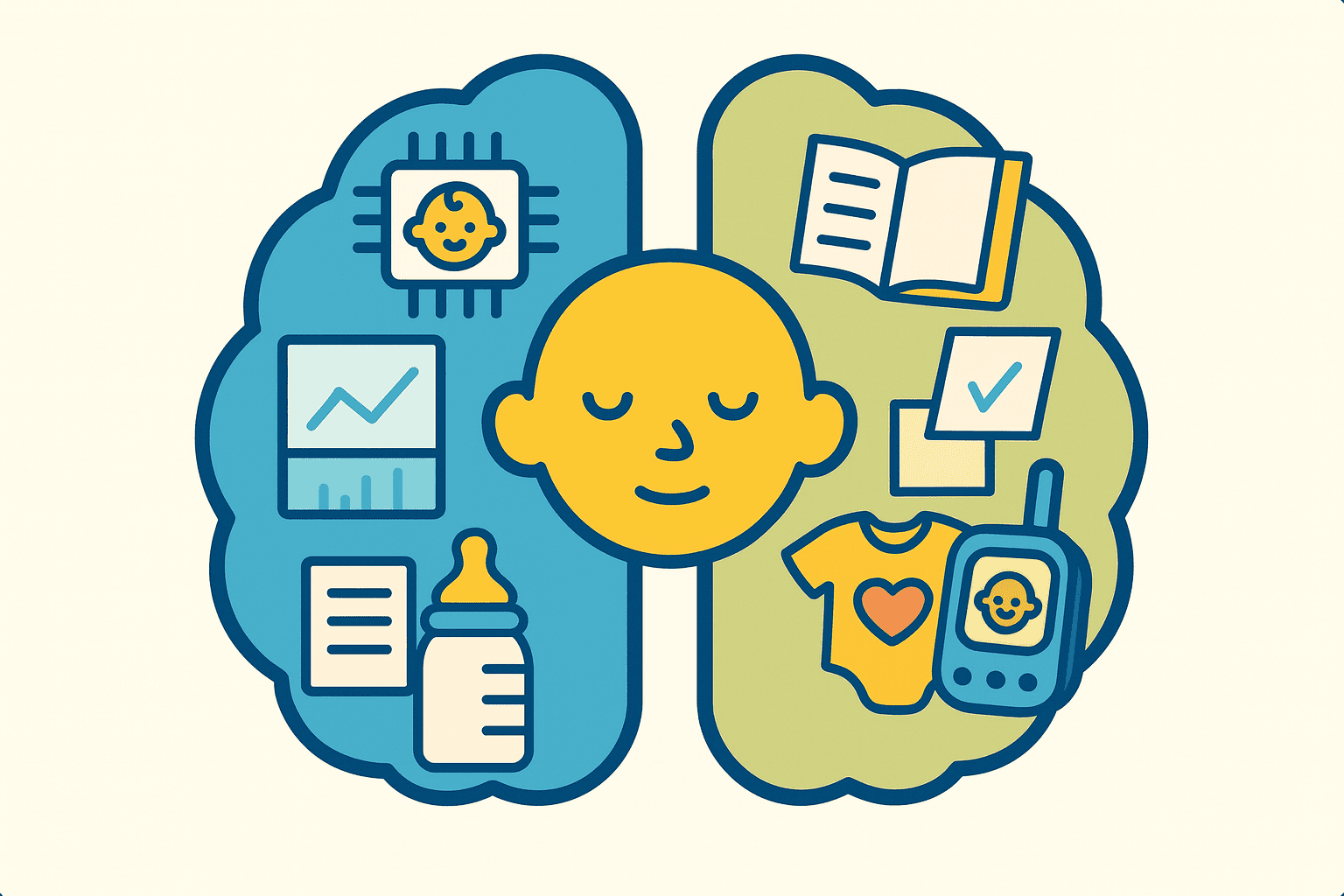
AI vs Traditional Baby Registry Planning: Complete 2025 Guide
Compare AI-powered baby registry tools with traditional planning methods. Discover the benefits and drawbacks of each approach to help you choose the right method for 2025.
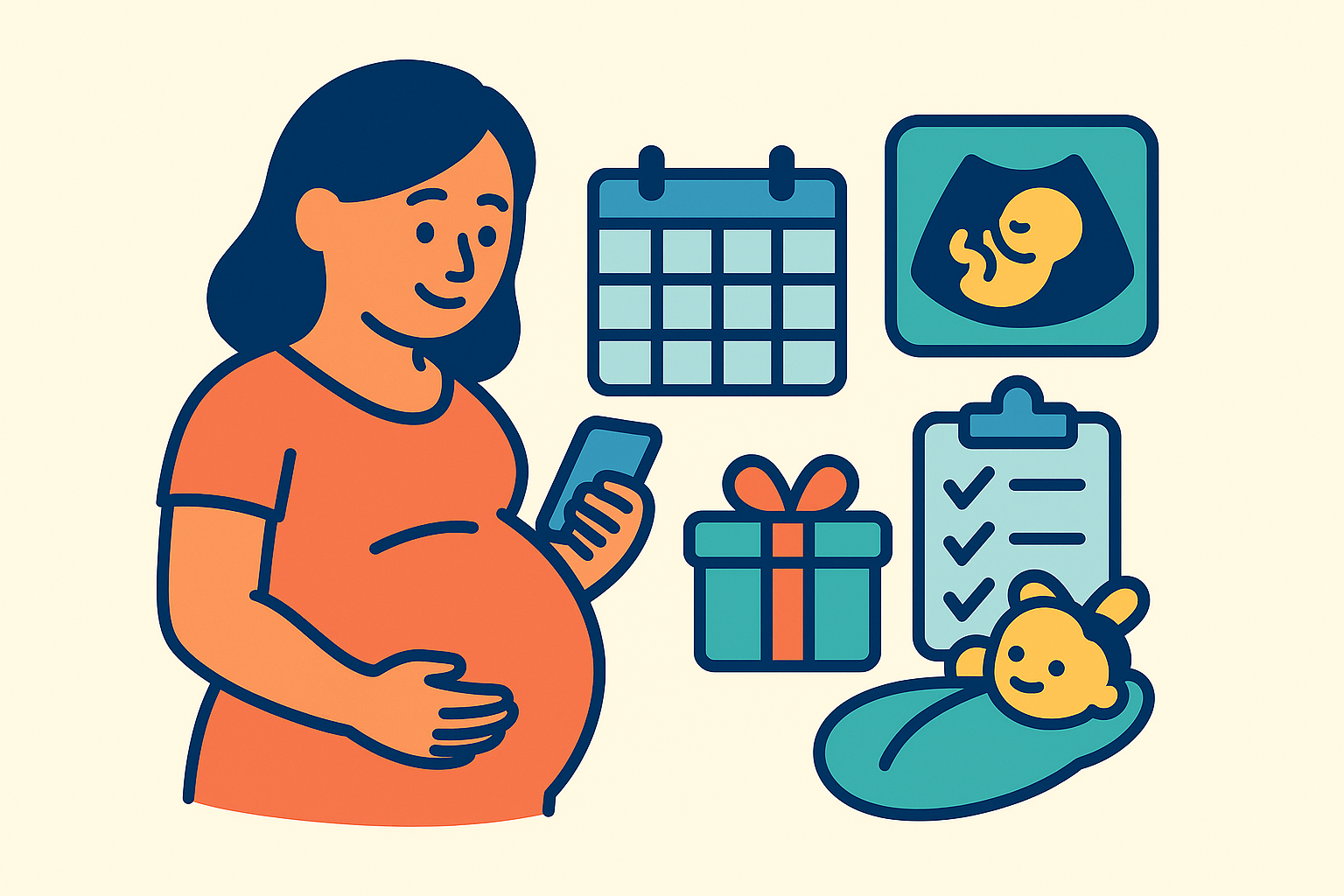
When Should I Start My Baby Registry? Expert Guide 2025
When should you start your baby registry? Start early at 12-14 weeks to maximize your completion discount and give friends time to shop. Get expert timing tips for 2025.

Common Baby Registry Mistakes: 2025 Guide
Creating a baby registry is exciting. and admittedly overwhelming. Here are the top mistakes new parents make on their registries and how to avoid them in 2025.
